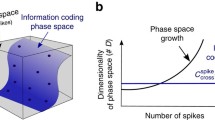Abstract
Correlation measures are important tools for the analysis of simultaneously recorded spike trains. A well-known measure with probabilistic interpretation is the cross-intensity function (CIF), which is an estimate of the conditional probability that a neuron spikes as a function of the time lag to spikes in another neuron. The non-commutative nature of the CIF is particularly useful when different neuron classes are studied that can be distinguished based on their anatomy or physiology. Here we explore the utility of the CIF for estimating spike-time jitter in synaptic interactions between neuron pairs of connected classes. When applied to spike train pairs from sleeping songbirds, we are able to distinguish fast synaptic interactions mediated primarily by AMPA receptors from slower interactions mediated by NMDA receptors. We also find that spike jitter increases with the time lag between spikes, reflecting the accumulation of noise in neural activity sequences, such as in synfire chains. In conclusion, we demonstrate some new utility of the CIF as a spike-train measure.
Similar content being viewed by others
References
Brillinger DR (1992) Nerve cell spike train data analysis: a progression of technique. J Am Stat Assoc 87(418):260–271
Brody CD (1999) Correlations without synchrony. Neural Comput 11:1537–1551
Brown EN, Kass RE, Mitra PP (2004) Multiple neural spike train data analysis: state-of-the-art and future challenges. Nat Neurosci 7(5):456–461
Brown EN, Barbieri R, Ventura V, Kaas RE, Frank LM (2001) The time-rescaling theorem and its application to neural spike train data anlysis. Neural Comput 15:965–991
Danóczy M, Hahnloser RHR (2006) Efficient estimation of hidden state dynamics from spike trains. In: Proceedings of NIPS2005—Neural information processing systems: natural and synthetic, Vancouver
Dave AD, Margoliash D (2000) Song replay during sleep and computational rules for sensorimotor vocal learning. Science 290(5492):812–816
Grün S, Diesmann M, Aertsen A (2002) Unitary events in multiple single-neuron spiking activity: I. Detection and significance. Neural Comput 14(1):43–80
Grün S, Diesmann M, Aertsen A (2002) Unitary events in multiple single-neuron spiking activity: II. Nonstationary data. Neural Comput 14(1):81–119
Grün S, Diesmann M, Grammont F, Riehle A, Aertsen A (1999) Detecting unitary events without discretization of time. J Neurosci Methods 94(1):67–79
Gutkin B, Ermentrout GB, Rudolph M (2003) Spike generating dynamics and the conditions for spike-time precision in cortical neurons. J Comput Neurosci 15(1):91–103
Hahnloser RHR, Kozhevnikov AA, Fee MS (2002) An ultra-sparse code underlies the generation of neural sequences in a songbird. Nature 419:65–70
Hahnloser RHR, Kozhevnikov AA, Fee MS (2006) Sleep-related neural activity in a premotor and a basal-gnalgia pathway of the songbird. J Neurophysiol. doi:10.1152:jn.01064.2005
Harsch A, Robinson HP (2000) Postsynaptic variability of firing in rat cortical neurons: the roles of input synchronization and synaptic NMDA receptor conductance. J Neurosci 20(16):6181–6192
Jarvis MR, Mitra PP (2001) Sampling properties of the spectrum and coherency of sequences of action potentials. Neural Comput 13(4):717–749
Mooney R, Konishi M (1991) Two distinct inputs to an avian song nucleus activate different glutamate receptor subtypes on individual neurons. Proc Natl Acad Sci USA 88(10):4075–4079
Palm G, Aertsen AM, Gerstein GL (1988) On the significance of correlations among neuronal spike trains. Biol Cybern 59(1): 1–11
Perkel DH, Gerstein GL, Moore GP (1967) Neuronal spike trains and stochastic point processes. II. Simultaneous spike trains. Biophys J 7(4):419–440
Schreiber S, Fellous J-M, Tiesinga P, Sejnowski TJ (2004) Influence of ionic conductances on spike timing reliability of cortical neurons for suprathreshold rhythmic inputs. J Neurophysiol 91(1):194–205
Stark LL, Perkel DJ (1999) Two-stage, input-specific synaptic maturation in a nucleus essential for vocal production in the zebra finch. J Neurosci 19(20):9107–9116
Tuckwell HC (1988) Introduction to theoretical neurobiology, vol 2, chap 10, Cambridge studies in mathematical biology. University of Cambridge, Cambridge pp 243–246
Author information
Authors and Affiliations
Corresponding author
Rights and permissions
About this article
Cite this article
Hahnloser, R.H.R. Cross-intensity functions and the estimate of spike-time jitter. Biol Cybern 96, 497–506 (2007). https://doi.org/10.1007/s00422-007-0143-7
Received:
Accepted:
Published:
Issue Date:
DOI: https://doi.org/10.1007/s00422-007-0143-7




